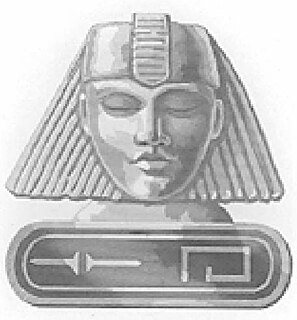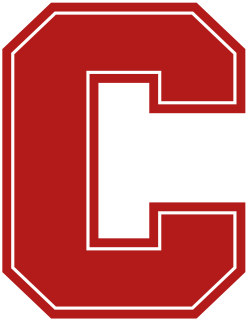Related Research Articles
Edgar Lawrence Kaw was an American football player. He attended Cornell University, where he was a prominent halfback on coach Gil Dobie's Cornell Big Red football team, graduating in 1923. He was a shifty open-field runner known as one of the sport's greatest. His stride had one foot farther than the other. Kaw scored 90 points in 1921. That year, Cornell beat Penn 41–0 in the mud, and Kaw scored five touchdowns. Kaw "skipped over the ooze and water as if he were running on a cinder track, sidestepping a small lake and a Penn tackler with one and the same motion." He was elected into the Sphinx Head Society during his senior year. Kaw played 11 games for the Buffalo Bisons in 1924.

The Cornell Big Red football team represents Cornell University in National Collegiate Athletic Association (NCAA) Division I Football Championship Subdivision (FCS) college football competition as a member of the Ivy League. It is one of the oldest and most storied football programs in the nation. The team has attained five national championships and has had seven players inducted into the College Football Hall of Fame.

George R. Pfann was an American football player and coach. He played college football at Cornell University, where he never lost while starring as a quarterback, twice named an All-American. Before graduating from Cornell in 1924, Pfann also played on the lacrosse and basketball teams, and was elected to the Sphinx Head Society. He then studied law at Cornell while serving as an assistant football coach and freshmen basketball coach. Pfann completed his law degree at Brasenose College, Oxford as a Rhodes scholar. From 1931 to 1935, Pfann was the head football coach at Swarthmore College, compiling a record of 8–26–1. He was elected to the College Football Hall of Fame as a player in 1957.

The Sphinx Head Society is the oldest senior honor society at Cornell University. Sphinx Head recognizes Cornell senior men and women who have demonstrated respectable strength of character on top of a dedication to leadership and service at Cornell University. In 1929 The New York Times held that election into Sphinx Head and similar societies constituted "the highest non-scholastic honor within reach of undergraduates."
Charles Bliven "Chick" Mason was an American college football player and coach and lawyer. Mason's first coaching job was for Kentucky State College—now known as the University of Kentucky—in 1895, where he posted a record of 4–5. His next job was as the sixth head football coach at Colgate University in Hamilton, New York; he held that position for three seasons, from 1897 until 1898 and again in 1901. His record at Colgate was 9–12–1. He was a member of the Cornell University class of 1895.
Jonathan Edwards "Jack" Ingersoll was an American football player and coach. He served as the head coach at Colgate University in 1911 and at Virginia Agricultural and Mechanical College and Polytechnic Institute (VPI)—now known as Virginia Tech—in 1916, compiling a career college football record of 10–8. Ingersoll was the 16th head football coach for the Colgate University Raiders located in the Village of Hamilton in Madison County, New York and he held that position for the 1911 season. His coaching record at Colgate was 3–6. He died in 1967.
Ray Van Orman was an American veterinarian and college football and lacrosse coach. He served as the head lacrosse and football coach at Johns Hopkins University, from 1920 to 1935 and 1926 to 1935 respectively, and the head lacrosse coach at Cornell University from 1940 to 1949. Van Orman was inducted into the National Lacrosse Hall of Fame in 1992.
Aleph Samach was a junior honor society at Cornell University that existed from 1893 until 1981. It was founded on four pillars: leadership, loyalty, service, and honor. Unlike most collegiate secret societies, which have primarily senior membership, Aleph Samach was composed mostly of juniors. While senior members played an advisory role within the society, Aleph Samach's primary goal was "to promote the greater good of the Cornell community by connecting junior leaders, cultivating their leadership skills and developing their commitment to campus service."
The 1920 Wisconsin Badgers football team was an American football team that represented the University of Wisconsin in the 1920 Big Ten Conference football season. The team compiled a 6–1 record, finished in second place in the Big Ten Conference, shut out four of seven opponents, and outscored all opponents by a combined total of 141 to 29. John R. Richards was in his fourth year as Wisconsin's head coach.

Touchdown, or the Big Red Bear, is the unofficial mascot of Cornell University. The first mascot was a black bear introduced in 1915 by the Cornell University Athletic Association. Three more live bears over the course of approximately two decades also made appearances at Cornell until the live bear was replaced by costumed students some years later. Touchdown appears on the logo for Cornell Athletics, and is represented in a statue erected outside Teagle Hall in 2015.
The 1889 Yale Bulldogs football team represented Yale University in the 1889 college football season. In their second season under head coach Walter Camp, Yale compiled a 15–1 record, held opponents scoreless in 12 games, and outscored all opponents by a total of 664 to 31. Its only loss was in the final game of the season against rival Princeton by a 10–0 score.
The 1920 All-Big Ten Conference football team consists of American football players selected to the All-Big Ten Conference teams chosen by various selectors for the 1920 Big Ten Conference football season.
The 1906 Penn Quakers football team represented the University of Pennsylvania in the 1906 college football season. The Quakers finished with a 7–2–3 record in their fifth year under head coach Carl S. Williams. Significant games included a 24 to 6 loss to the Carlisle Indians, a 17 to 0 victory over Michigan, and a scoreless tie with Cornell The 1906 Penn team outscored its opponents by a combined total of 186 to 58.

The Columbia–Cornell football rivalry is the American college football rivalry between the Columbia Lions and Cornell Big Red, the two Ivy League teams in New York State. In 2010, the game was named the Empire State Bowl, and the teams began competing for the Empire Cup. Since 2018, it has been the final game on each team's schedule.
The 1894 Cornell Big Red football team was an American football team that represented Cornell University during the 1894 college football season. In their first season under head coach Marshall Newell, the Big Red compiled a 6–4–1 record and outscored all opponents by a combined total of 178 to 58. Pop Warner was the team's captain.
The 1910 Cornell Big Red football team was an American football team that represented Cornell University during the 1910 college football season. In their first season under head coach Daniel A. Reed, the Big Red compiled a 5–2–1 record and outscored all opponents by a combined total of 165 to 44. Two Cornell players received honors on the 1910 College Football All-America Team: end Harold Eyrich ; and tackle William Munk, Cornell.
The 1919 Williams Ephs football team represented Williams College during the 1919 college football season.

The Colgate–Cornell football rivalry is an American college football rivalry between the Colgate Raiders and the Cornell Big Red. The two teams have met 101 times since their first meeting in 1896, and Colgate–Cornell was the 17th most-played college football rivalry as of 2013. Cornell has played Colgate in football more times than any other opponent except Ivy League rivals Penn and Columbia. Cornell leads the series 50–49–3, but Colgate has won 29 of 36 meetings since 1980.

The Ezra Cornell statue is a monumental statue in Ithaca, New York, United States. Located on the Arts Quad of the Cornell Central Campus, the monument honors Ezra Cornell, the co-founder and namesake of Cornell University. The statue, designed by Hermon Atkins MacNeil, was dedicated in 1919.
The 1912 NYU Violets football team was an American football team that represented New York University as an independent during the 1912 college football season. In their sixth year under head coach Herman Olcott, the team compiled a 2–6 record.